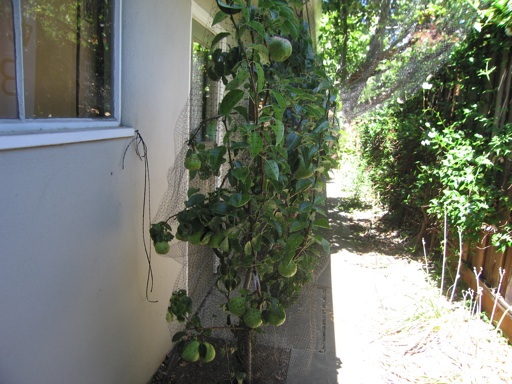Multi-grafted Pear Tree
When I first moved into the house I live in, there was a small tree growing near the side door of the garage, crammed into a 2-foot strip between the house and a concrete pathway. The tree produced large fuzzy yellow fruits in the fall that resembled apples. I eventually discovered that the fuzzy yellow fruits were quinces. It turns out quinces are so sour they can’t be eaten fresh. They are mainly used to make jams and jellies.
In any event, I noticed some scrawny branches were growing from the bottom of the tree that had different looking leaves than the quince. I was able to identify those branches as pear branches, because there are two other pear trees on the property that had the same type of leaves. After doing some research, I figured out that the previous owners of the property had intended to plant a third pear tree, not a quince. It turns out that pear scions are often grafted onto quince rootstocks. However, rootstocks often grow suckers. If the suckers are not cut back, they can grow into a tree and eventually kill the scion.
After deciding we’d rather have another pear tree than a quince tree, we cut back the quince sucker to near where the pear scion was grafted onto it. That was about 3 or 4 years ago. Since then, the pear scion has grown considerably and produced pears. It bloomed during the quince years, but it never set any fruit. This year, it has produced about 20 pears (see above picture), which is impressive for such a small tree. The quince was a vigorous grower, so I think the tree developed a substantial root system prior to when we finally cut back the quince sucker.
A few years ago, I realized that this pear tree was producing two different looking types of pears. One type of pear was thinner in shape and ripened in August. It looked and tasted like a Bartlett pear. The other type of pear was fatter in shape, had a different color skin, and ripened much later. It looked and tasted like a Comice pear. So it turns out this tree is a multi-grafted pear tree. It was an interesting choice, because the two other pear trees on the property that were planted by the previous owners are a Bartlett and a Comice. Somebody really liked pears, which is fine with me because I really like them too. Most of the pears in this picture are Bartlett pears.
August 10 2012 10:26 pm | Pears
